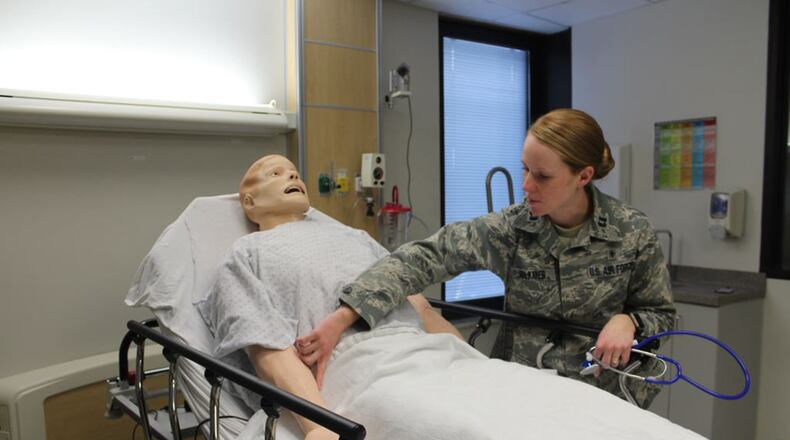Previously located in a classroom in the basement of the hospital, the simulation center had been providing training in a makeshift hospital room with limited equipment and resources.
After relocating to a section of the hospital that was previously part of the intensive care unit, the center now has seven enclosed rooms with complete hospital room features available for training. In addition, a simulation operator station has been positioned outside the rooms to allow remote monitoring and control of training scenarios, which further enhances the realism of the instruction.
“The simulation center provides realistic training for healthcare personnel to learn, challenge and hone their skills,” said Capt. Catherine Volkmer, 88th Medical Group sustainment medical and readiness trained program manager. “Participants are able to train in an environment that is psychologically safe and presents zero physical risk because they can first practice on mannequins versus an actual patient.”
Volkmer said now that the simulation center has relocated, training can be more realistic and more recognizable for the participants as it is conducted in real hospital rooms with medical equipment normally in a room, such as in-wall suction, monitors, call lights and sinks.
Simulated training is offered to an array of healthcare personnel, such as physicians, nurses and medical technicians, to include paramedics, emergency medical technicians, and respiratory therapists. In addition, the center provides critical care training and the hands-on portions of advanced adult and pediatric life support certification courses.
“The simulation center focuses on individual, team and unit training for skills that are high risk, low volume,” said Volkmer. “We have various equipment available to all units in the hospital to accomplish Air Force specialty code training requirements. Certain training is required for some providers in order to do their daily job therefore we take simulation training very seriously otherwise our patients cannot be seen.”
Volkmer said published literature states that effective simulation training is about the transfer of learning so what students learn in our simulation center, they can transfer that into real-life scenarios.
“We utilize mannequins that provide life like physiological responses,” said Volkmer. “Through simulation, participants learn how to use the equipment and care for the patient so when an actual medical event occurs, the learning transfers and they are confident on how to respond. This is part of providing trusted care with zero harm to the patient.”
The simulation center also provides readiness training, including trauma injury related courses.
“If deploying, medics need exposure on how to treat blast and traumatic brain injuries before they go,” said James Schlub, 88th Medical Group sustainment medical and readiness trained program administrator. “Our simulation operator has the ability to control the scenarios and can trigger the mannequins to simulate bleeding, limb loss or show signs of brain injury so students have to administer the appropriate medical treatment in real time.”
At a control station outside of the training room, Johnny Cartwright, certified healthcare simulation operations specialist, is the 88th Medical Group simulation operator and has the ability to customize and control the actions of the mannequins to whatever training is required.
“Depending upon the mannequin that is utilized, they can be programmed to exhibit various vital signs as well as sweat, bleed, produce urine, blink their eyes or dilate their pupils and to modify respiratory functions such as the rate and depth of breathing,” said Cartwright. “I can then observe the scenarios through monitors at the station as students participate in the training.”
Mentored and trained by innovators from the Center for Medical Simulation located in Boston, Cartwright is one of a 180 certified healthcare simulation operations specialists in the world. In addition, Cartwright is trained in medical modeling and can create silicone organs and tissues used for simulated training including surgical procedures.
“What I make is also reusable so it saves money,” said Cartwright. “We are bringing a piece of Hollywood into the medical field by using make-up artist techniques and materials to create life-like moulage, silicone organs and artificial blood. I am also very familiar with the components of each simulator so I can provide preventative maintenance and repair versus having to ship out the equipment that could delay training.”
“Simulation is the perfect conduit for medical professionals to learn skills and gain more confidence in their craft which in turn transfers into providing the best patient care possible,” said Volkmer.
The simulation center open house is open to anyone with base access and is located in room 3GC1 on the third floor of the medical center across from the intensive care unit.
For additional information on the simulation center, call 937-257-9431 or email at 88.humansimulation@us.af.mil.
About the Author
